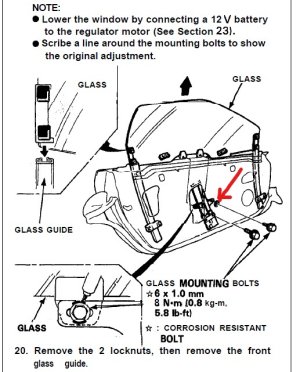Wild Turkey has it mostly covered.
This diagram is from the service manual. The red arrow marks the hole in the inner door skin that is used to access the front mounting bolt for the glass.
View attachment 190383
Clearly, the window regulator has to be powered up to allow you to lower the glass to access that bolt. When I did this,
before I removed that bolt I ran a strip of duct tape along the full base of the glass as Wild T described With the bolt removed, I peeled the tape back and manually lifted the window into the raised position and then secured it there with the duct tape (lots of it because I was paranoid - tape cheap < glass expensive). With the window back in the full raised position the regulator comes out easily. As noted, if all you are doing is regulator maintenance then you do not need to remove the door glass.
The window regulator mechanism certainly contributes to poor window operation; but, the guides (tracks) that the window moves up and down in also contribute to window operation problems. Completely cleaning and re lubricating the guides requires removal from the door which is a fair amount of work and potential grief because even with marking the retaining bolts as described in the service manual you end up with a potential need to go through the glass adjustment process which is a real pain on a T roof. I had to remove the back guide on my car because I was replacing torn door sashes which allowed me to clean the back guide and lubricate it. I did not want to remove the front guide, so after re installing the rear guide I manually lowered the glass and ran solvent down the guide track to try and wash out the old grease. I then worked the glass up and down while applying more solvent to try and get the old grease out allowing the solvent to run out the bottom of the door cavity through the drains - this is not a very efficient process. After air drying, I worked Urea Grease in from the top and by reaching in the door cavity to apply grease to the guide (bloody hands from scratches on the door skin). I think
@Honcho has experimented and may have advice on a better grease than Honda urea which used to be the go-to grease for this.
The glass assembly has sliders which fit into the window guides. As I recall they are nylon like. Try to check and make sure the sliders are not obviously damaged. If the sliders are damaged no amount of regulator work is going to make for smooth window operation.
I did all this without removing the glass from the door, in part because I didn't have a good place to put the glass where I knew it would be safe. I just used lots of tape to hold it in place. I definitely removed the rear guide without removing the glass. I suspect that if you re install the rear guide you could then remove the front guide for cleaning without taking out the glass. Whether you choose to try and clean and re lube the guides is your choice. Removing the guides to clean and lubricate them is a fair amount of extra work and potentially puts you on the track to adjusting the door glass. Based upon personal experience, adjusting the door glass on a T roof is not a satisfying experience. The service manual guide to glass adjustment is based upon fresh door gaskets. If your door gaskets have 20+ years of set in them the measurements in the SM may not be so relevant. After adjusting to the factory spec, I now have more wind noise from my windows.







